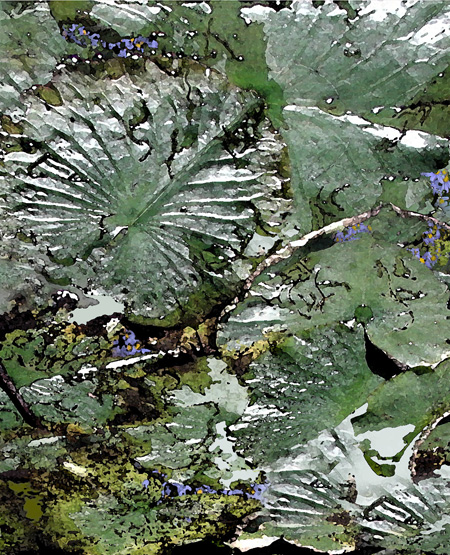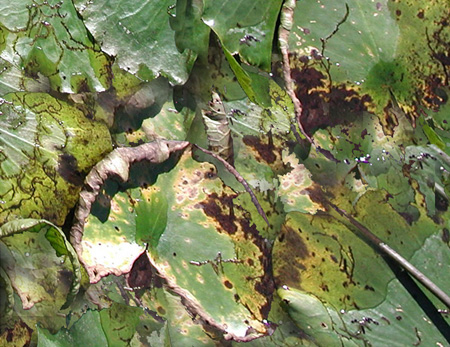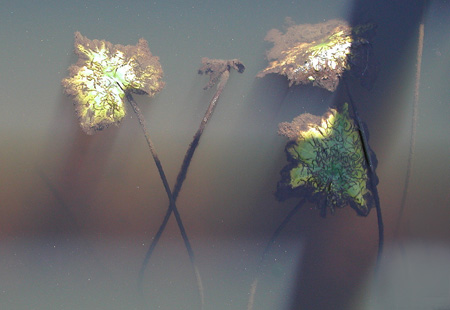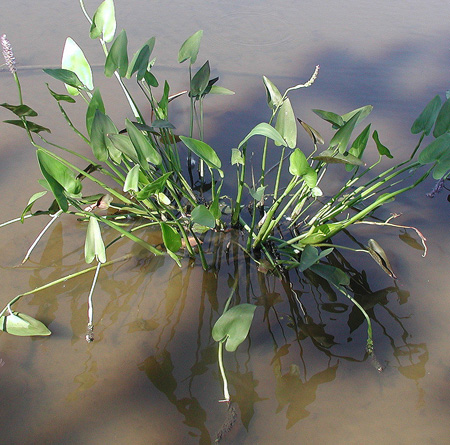People on this site take their photography seriously.
Me, I play around. I take my camera to a tidy little pond with a walkway in a nearby metro park, where I capture whatever the season and the light permit. Photographing the plant life there is somewhat like shooting fish in a barrel.
There are things that I forswore, but now I swear I do. I once considered the extent of my cunning to constitute the limits of my accomplishment, and looked askance at any number of the tools that I now unabashedly employ. And the images that I bring back from the pond are increasingly subjected to my ever laxer and self-indulgent propensities. Instead of rolling up my sleeves on location and really getting into the moment, I point and shoot and place my faith in the little Photoshop of horrors. This sort of thing was not supposed to happen – my parents raised me better than to click like that.
But I must admit that the slack I cut for myself can be fun. I might be wanting in light of self-imposed standards of handicraft, but allowing a computer to compensate for my weaknesses has opened up a richer and more fluid relationship between my experiences and my sensibilities.
The other day I was again at the pond. A late afternoon sun was at my back and the lily pads were in various states of tattered elegance.
In the one instance were lily pads that made me think of Pepperell’s paintings. They had lost their crisp ovals to age and had acquired a welter of shapes and colors. I took some shots and later dissolved the arrangements, using the magic wand and stamping, and replacing intervals of water with a kind of visual puree. I must admit that I then put the first image through the watercolor function to get highlights. I feel funny about the final product as I’m not sure if I controlled the process as much as the process controlled me.

I then tried the whole thing again, cropping another section from the original image. I went easy on the contrast and stayed away from the artistic effects. One can identify the subject matter, but I’m more content with the way that things flow together.

The next are two simple compositions. I cropped and removed some small distractions.A lovely thing can happen around the wooden walkway as its shadows dissolve into the somewhat murky water. The plants, too, join in and one can see effects such as this. The composition feels a little awkward to me, but it loses a sense of air if I try cropping the right side to any greater extent .

The next image is more or less a record shot. But I love the relationship of the reflections in the foreground to the shadows beyond.

Thus was a day at the pond.
Please feel free to play with these images and suggest changes. I am particularly interested in your reactions to the first image as it contains a degree of artifice. Is the second image better? Do you see any parallels between the first two and the work of Mr. Pepperell?

folks:
Please allow me to be the first to comment. I seem to have done something wrong as the images are huge. How do I correct that?
Jay,
look at the tutorial under ,posting guidance’
http://www.artandperception.com/posting-guidance/uploading-an-image-that-is-exactly-the-right-size-for-your-post/
Birgit:
Thanks for being so prompt. I just went back and cleaned up the size issue and things look better I think.
Textures!
The first picture looks like metallic paint peeling from a sculpture.I prefer the softer look of the second one, an intriguing composition of decaying leaves. The third one looks specious to me. The last picture is a lovely shot.
Do you see any parallels between the first two and the work of Mr. Pepperell?
Complicated texture:
Yes
Motif:
No, Pepperell’s painting from Steve’s recent post makes me think of flesh while your first picture reminds me of metallic paint and your second picture of plants.
Gruesomeness:
Yes, your first picture. Decay of man-made object such as peeling of metallic paint strikes me as unpleasant compared to the natural rotting of leaves shown in your second picture.
Re Mr. Pepperell, I rotated the picture from Steve’s post by 90 degree, forgot, CW or CCW, and it did have a resemblance to the Rape of the Sabine Women. I could possibly live with Ricci’s painting but not with Pepperell’s.
Jay,
These definitely relate to Pepperell’s “visual indeterminacy” that we were discussing last week. I’m not quite sure what I’m looking at at first. The green color and one more prominent leaf shape provide the first clues, and it then takes a little longer to figure out, from the flatness and the highlights and other effects, that I’m looking down at leaves at a water surface.
The difference from Pepperell’s own paintings is that your photographs do resolve into clearly recognizable scenes. I think this can be quite effective when the resolved image is worthy of the perceptual effort.
On the images: I didn’t see the post before, but everything looks fine now. Larger images can look great in some browsers, but width over 450 pixels can cause the display to break up in Internet Explorer (the sidebar apparently disappears , going to the bottom of the page), which is used by many visitors.
Guys:
Having trouble commenting. Let’s see if this works.
It appears that, as a member, I need to login before commenting.
I had a whole essay that went south on me. To summarize briefly:
Bridgit:
Concerning the third image, did you mean to use the term “specious”? If so, I must declare that the things were actually there and I didn’t fool around with them very much.
The first image does do great damage to the appearance of the water lilies.
Steve:
Looks like things are getting worked out.
I agree that the wand and stamp methodology seems to have some utility, given the right subject.
From birgit not bridget. Birgit pronounced with a hard ‘g’ so that it does not sound like ‘birdshit’.
I am glad that I challenged your third image. I now like it the best. It is delicious. ¬I blew it up to 200% and the larger size looks even better.
I love the background color, mauve/lavender and the delicate shapes.
After having looked at the first two pictures, I had concluded that you created the third picture by extensive retouching, nice old term for cleaning up junk to create Japanesee delicacy.
I accept the picture as a more or less realistic presentation but not as photoshop simplified minimilism. Am I a phony? Art photography is not like newspaper photography. And yet, the fact that the photo represent a natural scene makes it compelling to me.
I am confused about my criteria for artistic photography.
The first photo is spectacular!
Birgit:
Bridgit? Where did that come from?
I am rather taken by the third image myself. Here’s what I did: 1. I cropped out a reflection of myself taking the shot and otherwise moved in a little on what you now see. 2. I tried unsuccessfully to live with an underwater feature in the lower left corner. This I removed with the stamping technique. I was surprised at how well it disappeared. 3. Working with the sampler tool and the brush, I went about getting rid of as many little specks of stuff sitting on the surface as I could. 4. I played around some with the curves tool, but found that the camera had taken a good shot. 5. I then spent too much time cropping and undoing repeatedly in an effort to find the right relationship between the plants and the extent of the water medium. I’m still a little dissatisfied.
Angela:
Thank you. It would be interesting to see a duck try to land on that stuff.
Brigit:
You mentioned newspaper photography. The Plain Dealer has this nice policy of presenting a lot of artistic shots. The staff photographers are not restricted to who, what, where, when stuff, but will often get their best efforts printed.
Jay,
In the waterlily leaves, I’m seeing your foam cuts. But in the last two something else is happening. Delicious background colors on the last two.
I approve of your futzing around with photoshop — it’s just a different kind of paint brush/tube/whatever. I think you have to set up your own challenges, not let the old guys (or white glove police, as we calls them) dictate what you ought to be doing.
June:
Darn, it just happened again. Seems I have to sign in before I can comment.
To summarize: thanks. I’m ambivalent about technological aids as I think that they tend to erode as much as they enhance. I’m not sure that I can remember my multiplication tables any more.
Jay —
Why do you want to remember your multiplication tables? Oh, that’s right — just in case you are out in the woods where there are bears and lions and stuff and you have to start a fire….
Jay,
Have you tried leaving the reflection of your head in the third picture?
Hello… thought i’d drop a little bomb here… Is photography really art? i’m tired of reading conceptual wiki articles, I really would like to know what people think. What makes it art exactly? where’s the skill? the craftsmanship? Photographer only finds, s/he does not actually do anything. He’s like a painter who only arranges the composition, without putting in any real effort.
Elijah,
Hmmm… where to start? There are so many definitional issues here: what for you is art? craft? photography?
If you click the shutter without looking, and take the unaltered result from the photo lab or your computer, you might say it’s not art. If you select among the infinite possible directions and settings for the camera, if you follow one among the infinite ways of processing the film or digital file, then, depending on the choices made, you might call it art. If art is not the exercise of artistic judgment (whatever that is) in creating an object, what is it?
Art for me is the collection of these forms of expression: literature, architecture, cinema and all the fine arts. Traditional, and simple.
i can agree that processing photographs in photoshop can be called “the art of.” it certainly demands skills. i suppose it is a craft, but i still don’t see how the final result can be called art in the traditional sense. it is difficult for me to accept that manipulating a computer program can be compared to painting. maybe i’m too all or nothing in this, but some things just need to be defined clearly. hence, the way i see it, the question remains open. i’m fascinated and troubled by it.
i looked at some first ever made photos, portraits of poets and scientists from the 19th century, by this lady, forgot her name. beautiful light, composition, etc. but then the subject itself — all the “psychological subtleties…” damn, what subtleties?! they are the merit of the sitter any way i look at it! what did the photographer do? merely passed them on, perhaps enhanced them, but not more than that.
you mention the exercise of artistic judgment… i would like to challenge that: art critics also exercises their artistic judgment! in fact, anyone who is receptive to art in some measure, does exactly that. Seems to me that art is more than that. It takes some kind of actual practical “dirty” skill. Something inexplicable that occurs when the mind connects with the hands that create. Perhaps you are on to something here. if photography is just the exercise, then, if i’m correct, it lacks the practical “dirty” skill that would make it art. ugh… maybe photography is somewhere in between.
btw
Nice blog you have, and i enjoy reading it. Love your style.
art critics also exercises their artistic judgment! in fact, anyone who is receptive to art in some measure, does exactly that.
Agreed! Though they’re not creating a tangible artwork (dirty hand work?). Still, in my view, they’re participating in the process, obviously in a different way.
Painting can be a garage or a Rembrandt. Photography can be a passport photo or a Chuck Close daguerrotype. If you try to make something like the latter, I think you’ll appreciate the skill. Your choice whether to call it art.
Thank you for your comments. The nature of photography, and how it fits with traditional arts, is something I’m still grappling with.
I feel like painting the leaves floating in the murky water. The amazing thing about this image is that there is no beginning and no end, just floating evanescence that seem to be highlighted by the varying shades in the water… Liked your day at the pond and might try and use a couple of these for some of my doodling – now that you have given us the go-ahead.
Has anyone thought of a group show of the members here on A&P?
Hello:
Checking to see if I’m on. Been away for a week and it looks like I’ve missed a great deal.
Hi Jay,
Thank heavens you’ve checked back in — I thought you might be DIAD (Dead-in-a-Ditch, as me dear ol’ mum used to say when she asked me to call home.) I’m going away in a couple of days and will be gone a week also, so lead on McDuff, while I’m still here to follow.
Birgit:
My travelings have left me a little detached from this string of comments. I haven’t gotten my head back in the picture yet, but in reference to your reference to my head in the picture, I must say that it would have produced a whole other frame of reference. As such, I was trying to get across the world that existed in that patch of water and its relationship to some undefined outer entity casting the shadows. In picture number four I pointed out the contrast of the reflections fronting the plants to the shadows behind. In number three its all shadows and no reflections to speak of. That was how it panned out. That said, your idea is a good one where reflections and shadows would have a more considered relationship.
June:
Had my mind in the gutter, but not my head in a ditch. Have fun – I did.
Sunil:
What kind of a group show would that be? As part of the blog proper?
Picture number three is one of those episodes wherein one tends to the matters at hand: capturing an attractive motif and then hewing and stitching into shape – to find later that it is better than one first thought. I know that I tend to zero in on some anticipated result and will then be disappointed if things don’t turn out that way, while missing the merits of an alternate outcome.
On group shows: I’d invite anyone to curate or simply initiate a group show. Examples of the former are The mystery of things and Chirping among the birds.
If you start one out with a piece of your own, the worst you can have is a solo exhibition.
Elijah:
Did you pull this string because it is there, or because PhotoShop is discussed?
Since I am the commenter of record, allow me to reiterate my feelings on the matter: that I am ambivalent about depending heavily on technology and always want to accord full credit to the tools that create given results. Secondly, that I don’t employ the term “art” a whole lot as it is a map on which roads do not tend to mutually connect. One might simply refer to any of these as images.
Folks:
On the subject of specific ambiguity, or ambiguous specificity, allow me to mention Gumbycat. She paints with fractals and comes up with some remarkable effects. Just Google gumbycat.